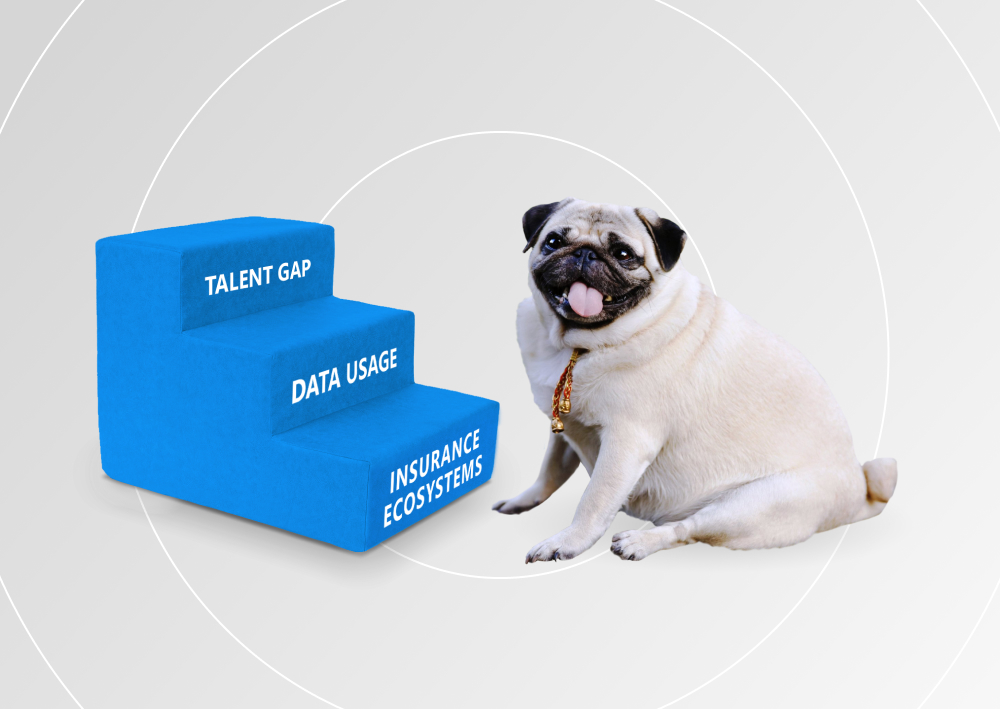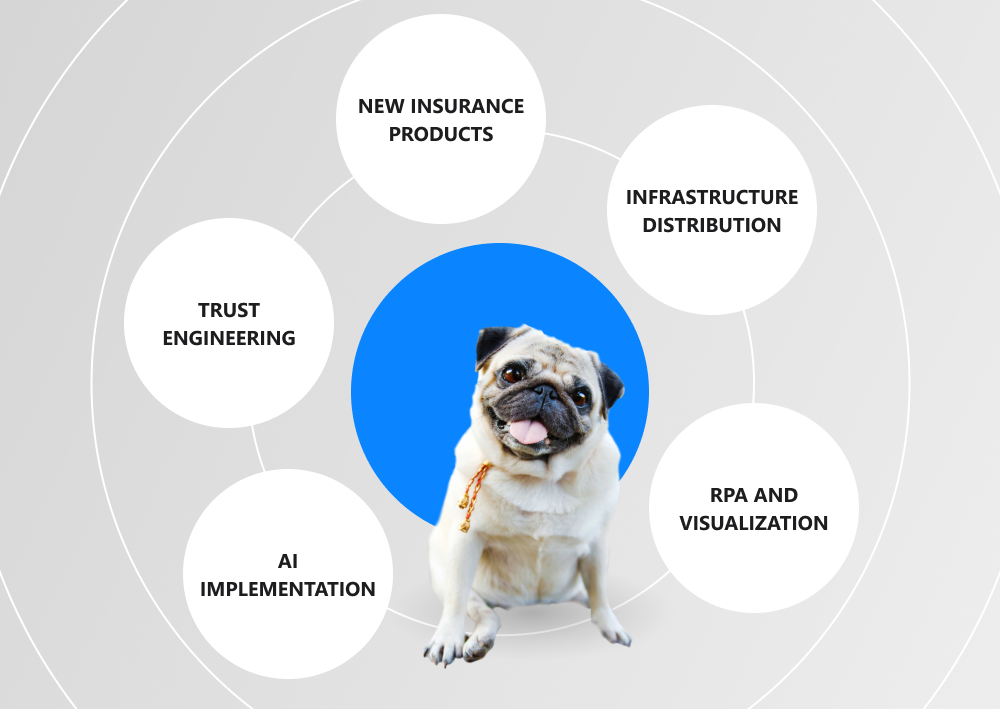According to Amara's Law, the effect of technology is usually overestimated in the short term, but in the long term, it is underestimated. Meanwhile, insurers are becoming more dependent on innovations and technologies for efficiency, security, and expanded capabilities. So, how can you define which insurance trends are the best for 2024? And which of them will improve the industry in the long run?
In our new article, we will review the latest technological tendencies of the insurance industry. Also, we will share our expert opinion on what will give you an essential competitive advantage.
WRITTEN BY:
Alexander Arabey
Director of Business Development
Contents
What Is Driving the Insurance Industry in 2024?
The first thing to notice about the insurance business today is that it is not as predictable and stable as it used to be just a decade ago. The main tendency that traditional insurers have to face now is the need to adapt to new challenges as fast as possible.
Numerous disruptions that seem to have no end in undermining our usual way of life have caused a growing demand for products tailored to our changing needs. For that reason, insurance executives have to give preference to more active marketing strategies and intense technology adoption to save their customers' loyalty and get new business prospects.
According to InsurTech Outlook, more than 25 percent of insurtech companies were to leave the insurance market in 2023 as a result of a wind-down or acquisition. Just a couple of years after investment in the industry hit a record high. The exit from the market will be accompanied by high inflation, a recession, and investors looking for more profitable companies.
We can already see some warning signs that investment in the insurance industry has reached a tipping point from an all-time high of $20.4 billion in 2021. In August, broker Gallagher Re reported that global investment in insurance technology is down 50% to about $2.4 billion in Q2 2022.
At the same time, Forrester says investment in the insurtech sector in 2023 reached the level we saw before the pandemic — about $7 billion.
What Are the Biggest Challenges Facing the Insurance Industry?
There is no doubt that the common global concerns about economic hurdles and sustainability will continue to influence our life. Moreover, rapidly evolving consumer preferences and demand for forward-looking insurance products pose new challenges to the insurance business. Let us have a look at the main pain points that the insurance industry has to solve these days.
Insurance Ecosystems: Displacing Traditional Insurers
Traditionally, size was a significant advantage for insurance companies. Furthermore, scaling and long-term planning have long been the main essential features for risk management in the insurance space.
However, modern consumers prefer convenient services of financial ecosystems, which are far more flexible and can be tailored individually. That is why today we also see the shift to uniting insurance products of smaller carriers or regional players into insurance ecosystems.
Meanwhile, that also brings concerns about enabling smooth and secure consolidation of all the components of various insurance carriers, insurtech companies, and services.
Turning Data into a Useful Tool
Most insurers have been hearing a lot about how emerging technologies can help upgrade insurance products. At the same time, there is an avalanche of promising tools at the market like artificial intelligence, machine learning, robotic process automation, advanced analytics, etc. So, the "only" thing to step on to the next level is to implement the best strategies.
Although innovations can be enormously useful, there comes a great challenge for insurance leaders. They have to make the right decisions to invest in technological solutions that can lead to better results for their particular business. In addition, such innovations require the recruitment of sought-after tech professionals and the extension of existing teams.
A Talent Gap in Hybrid Work Environment
So, high-level talents today are one of the leading forces of further development for insurance companies. However, attracting and retaining talents in competitive job markets is a difficult task for the industry. This is especially challenging when there is a huge need for trendy technological products.
One of the popular solutions is to turn to more flexible work models. But despite some definite benefits such as gaining access to qualified specialists who can work on a project basis or a part-time contract, there can also be many risks such as data security or regulatory mandates.
That is why it is essential to choose a reliable outsourcing partner which has rich experience in insurance software application development and follows strict global security standards.
What Are the Current Insurance Trends?
The emergence of core technology trends that we have been witnessing during the past few years has transformed nearly every industry. But which technological advancements will be the most promising in meeting customer expectations for insurance? We have handpicked five of the most notable trends.
AI Implementation
Indeed, many insurance companies are exploring new opportunities for introducing AI into insurance operating models. But the full potential of this technology has not been discovered yet. However, we believe that the most promising use cases will be:
- Explainable AI. The use of AI algorithms for in-depth analysis and making decisions will increase the level of trust in claims management and fraud detection.
- Personalization. Insurance companies can understand their customers way better with the help of advanced analytics models. And they can offer more individually tailored products.
- Chatbots. The immense volume of inquiries can be managed much more effectively via AI chatbots, which are available 24/7 and cost-effective.
- Fraud Detection. Efficient detection of new fraud patterns provides a powerful instrument for initial claims processing. So, insurers can take appropriate countermeasures immediately.
RPA and Visualization
Robotic process automation (RPA) has long been in the focus of the insurance industry, particularly for back-office operations. But the technology is also effective for claims management.
For instance, industrial IoT devices can perform real-time monitoring and apply predictive analytics tools for identifying possible claims. Moreover, empowered with advanced visualization solutions, such as 3D printing, the claims experience has a significant potential for tackling physical damage areas.
Infrastructure Distribution
The inevitable migration from traditional services to the cyber insurance ecosystem requires the intense adoption of massive data sets. To enable fast and secure data sharing and claims approval, leading carriers will have to increase the implementation of cloud and blockchain technologies.
Moreover, cloud- and blockchain-native insurers will get a competitive advantage and take the position of ecosystem orchestrators for distributors, carriers, reinsurers, insurtech, and other providers.
Trust Engineering
On the other hand, dealing with sensitive customer data poses a challenge for the insurance industry in creating robust trust architecture. Here, emerging technologies, such as blockchain, provide an effective strategy to reduce risk pressure. For example, insurers can effectively and consistently manage customer data in a protected manner.
Another practical use case of blockchain technology is identity management and verification. It also helps create resilient networks of zero-trust security and equal treatment, with a focus on protection against cyber intrusions.
New Insurance Product Categories
The evolving landscape of modern challenges prompts insurers to reimagine their traditional approach to customer relations. The introduction of innovative products tailored for mobile devices and wearables, for instance, not only enhances engagement but also promptly aligns with customer expectations. The incorporation of wearable and telematic sensors facilitates real-time monitoring of crucial parameters, such as the policyholder's health, providing opportunities for risk selection and pricing assessments.
Moreover, there exists a promising avenue for the insurance sector to leverage emerging technologies and craft more personalized and distinct offerings. This approach proves beneficial in catering to previously overlooked segments, such as gig workers. By employing advanced analytics and adopting a pay-as-you-go pricing model, insurers can extend insurance protection to these customers, addressing their specific needs.
Wrap Up
So, the trends highlighted in this article are reshaping the industry and creating new opportunities and existential threats to traditional insurance business models. And the evident tendency to build customer-centric, omnichannel, secure, and technologically empowered insurance ecosystems will continue transforming the industry.
That is why insurers should act now and do not underestimate the effect of current technological transformation in the long run.
Want to know more about our expertise and unique competence in insurance technological solutions delivery? Feel free to contact our specialists.

Contacts
Feel free to get in touch with us! Use this contact form for an ASAP response.
Call us at +44 151 528 8015
E-mail us at request@qulix.com









